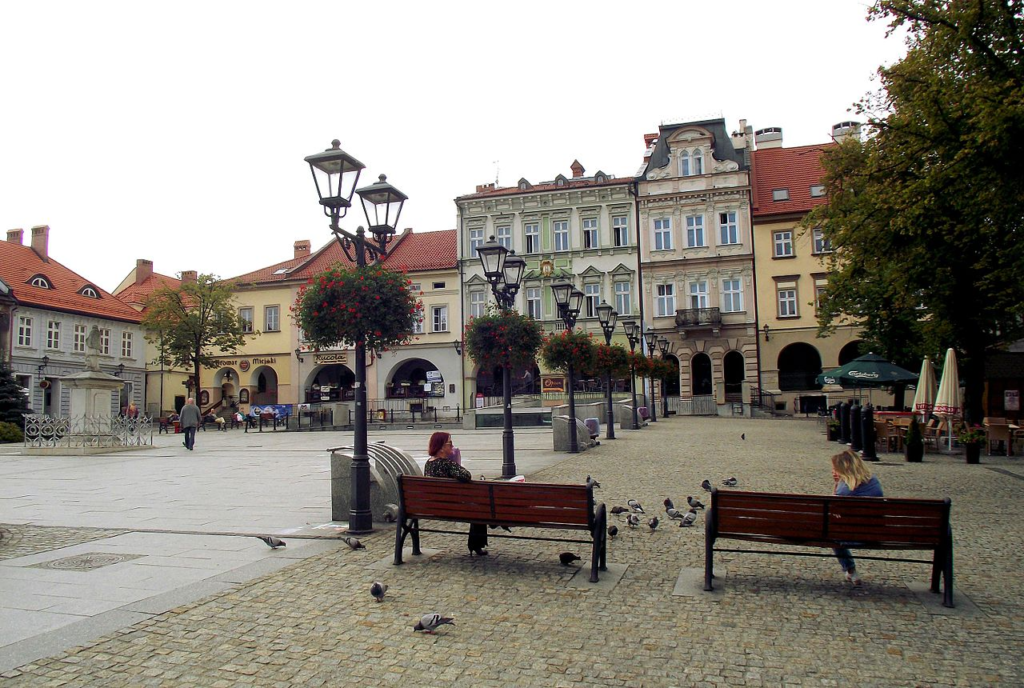Bielsko-Biała is a city located in the southern part of Poland, in the Silesian Voivodeship. It is situated on the slopes of the Beskid Mountains, near the border with Slovakia and the Czech Republic.
The city was created in 1951 by merging two cities: Bielsko and Biała. Bielsko has a long history dating back to the 13th century, while Biała was founded in the 18th century. The two cities were connected by a common history and culture, and they had a strong industrial base, which made them important centers of textile, metallurgical and machinery industries.
Today, Bielsko-Biała is a modern city with a population of around 170,000 inhabitants. It is known for its beautiful architecture, which reflects the city’s rich history and culture. The city has many museums, galleries, theaters and cultural institutions, and it is also a popular tourist destination, especially among winter sports enthusiasts.
Bielsko-Biała is also an important educational center, with several universities and technical schools located in the city. The city is well-connected with the rest of Poland and Europe, with a modern road and rail network, and an international airport located nearby.
The Castle of the Sułkowski Dukes
The castle in Bielsko-Biała is the oldest and largest historic building in the city. Built by the Cieszyn Piasts in the 13th century, it served as a border fortress for centuries, and is now the seat of a museum and one of the main tourist attractions of the city.

Photo taken from pinterest.com
Old Factory
The Museum of Technology and Textiles in Bielsko-Biała was established in 1983 in the post-industrial premises of ZPW „Bewelana”, and its activity initially consisted in collecting, inventorying and securing exhibits. It was only after several years that the Museum of Technology and Textiles was opened, and since 2013 it has been called the Old Factory.

Photo taken from muzeum.bielsko.pl
The Weaver’s House
The Weaver’s House in Bielsko-Biała is a museum located in Górne Przedmieście, where a draper’s workshop was located from the 18th century. After many years of reconstruction work, the building was opened to the public by the District Museum in 1992. Previously, the exhibition From cloth to silk was located on the first floor, which was liquidated in 2020 for conservation reasons, but is to return in a changed form

Photo taken from muzeum.bielsko.pl
Fałatówka
Fałatówka is a branch of the Historical Museum in Bielsko-Biała, located in the villa where Julian Fałat lived and worked for nearly 20 years. The idea of establishing a museum sprouted in May 1945, and finally the facility was opened to the public in August 1973. Currently, Fałatówka presents the works of the watercolor master and exhibits from his collections as well as archives, and the exhibition space has undergone several modernizations.
Photo taken from wilkowice.pl
The main square in Bielsko-Biała
historic market square, full of cafes, restaurants and shops. This is the center of the city, where there are many interesting sights, such as the Cathedral of St. Nicholas, historic tenement houses and the town hall

Photo taken from commons.wikimedia.org
Słowacki Park
Park Juliusz Słowacki in Bielsko-Biała was founded in 1898 on the site of the former choleric cemetery and shooting range of the rifle fraternity. The main object of the park is the House of Music, and the area also includes fountains, an artificial ice rink, a sports complex and two monumental oaks.

Photo taken from atrakcjedzieciece.pl
Bolek and Lolek
Monument to Bolek and Lolek in Bielsko-Biała, located in the courtyard at ul. Mostowa, in front of the southern building of the Sfera shopping center, shows two figures pointing their finger at a globe with the city of Bielsko-Biała marked. The ceremonial unveiling of the monument, made of bronze and weighing about 254 kilograms, took place in 2011, commemorating the main characters of the popular animated film produced in the Cartoon Film Studio in Bielsko in 1963-1964.

Photo taken from wikipedia.org
Polish Theater in Bielsko-Biała
The building of the Polish Theater in Bielsko-Biała, erected in the years 1889-1890 according to the design of Emil von Förster in an eclectic style, reminiscent of the Vienna Opera and the National Theater in Budapest. On the facade there are motifs of the Roman triumphal arch and statues of Apollo and muses. After the reconstruction in 1904-1905 and a general renovation of the facade in 2008, the theater gained a new revolving stage, air conditioning, new lighting and a cafe, and in front of the building there is a replica of a historic fountain from 1895.

Photo taken from slaskie.travel
Three Lipki
Trzy Lipki is a hill with a height of 386 m above sea level. in Bielsko-Biała, with a lime tree forest once overgrown and now extensive meadows. At the top there is a steel Cross of the Third Millennium, and the surroundings are a good vantage point. On the hill there is a tourist trail and the International Bicycle Trail, as well as a motocross track and a hamlet of the village of Stare Bielsko, which was independent until 1977

Photo taken from slaskie.travel
Tenement House „Under the Frogs”
The „Pod Żabami” tenement house is an Art Nouveau building in Bielsko-Biała from 1903, designed by Emanuel Rost Jr., with an imitation of half-timbered walls and a decorative facade. On the northern wall there are bas-reliefs of insects, and bay windows and a pseudo-tower above the entrances, while in the central part of the building there are figures of two frogs.

Photo taken from needpix.com
